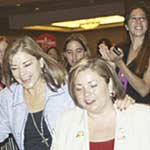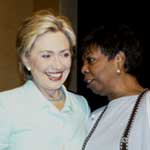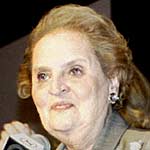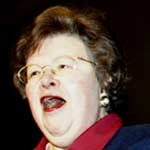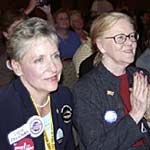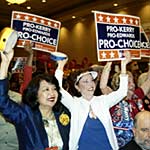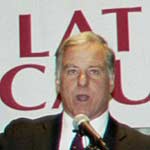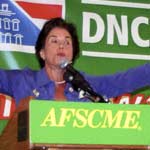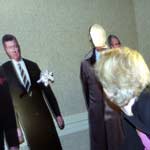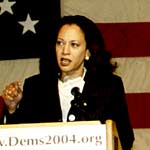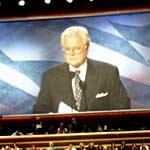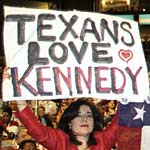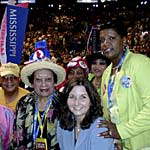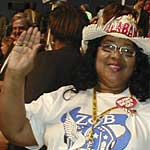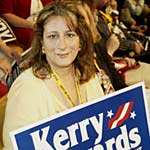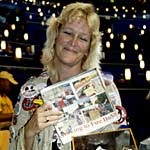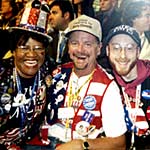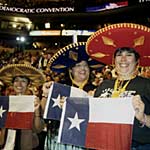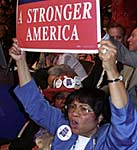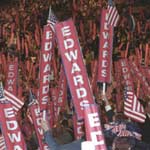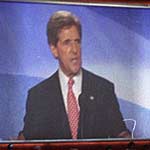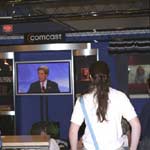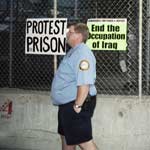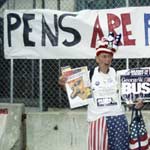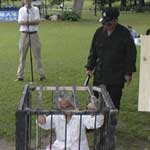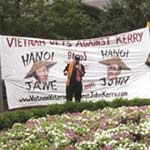Blogging the Democrats (2004)
Published on Senior Women Web, August 2004
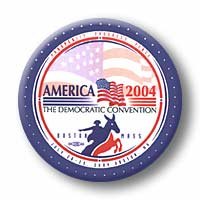
I wasn't going to go to the Democratic Convention this year. None of the publications I write for were given press credentials and I didn't have a place to stay.
But after making this quadrennial trek for forty years, primarily to write about women's activities and anything of interest to feminists, I couldn't stay away.
When my friend Denise, who also can't stay away, told me on Sunday evening before it started that I really should be there, I threw one good suit into a suitcase, grabbed my cameras, and caught the next cheap Chinese bus to Boston. The suit was just in case I got into something that was dressier than my photographer's vest, and the suitcase was to bring back the usual ton of paper and artifacts.
I thought I would have trouble getting into the convention, but would find a bed to sleep in by Monday night.
I was wrong on both counts. I had a press credential within an hour of arriving, but never did find a bed. The Dems had invited 35,000 delegates, staff, media and guests to Boston that week. They were joined by several thousand uninvited guests. Everyplace I looked there was no room at the inn. Instead I crashed in odd spots, where I couldn't take a shower, brush my teeth, or take off my clothes. By the time I returned home about 100 hours later, I was a little grubby.
Getting credentials
It's getting harder to get press credentials, even when you are a legitimate writer. The rules change for each convention. This year the Democrats bragged that "The Democratic National Convention Committee (DNCC) is granting unprecedented access to the authors of online web logs, more commonly known as 'blogs.' " To make room for the blogs, the political science journals were denied press credentials -- even the lowest level of press credential. Twenty years ago writers representing political science journals got the same press credential as political journalists, though not as many. Then they were bumped down to the equivalent of "student newspapers." In 2004 the Democrats (but not the Republicans) bounced them out altogether.
Since the closest I've ever come to representing a "mainstream" press
organization was when I wrote about the 1976 conventions for Ms magazine,
I've always worried about getting squeezed out. It happened this year.
Some web pages got press credentials, but Senior Women Web, which I've
written for since the 2000 Democratic Convention, did not.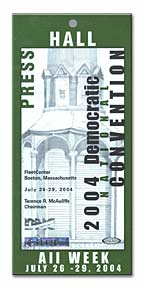
However,there are some advantages to being an aging perennial and this year I reaped one of them. When I walked into the Periodical Press Gallery office in the Westin Hotel soon after arriving in Boston, towing my suitcase behind me, I saw Ed Pesce, its Director, sitting behind a table, looking somewhat haggard. He has a hard job. Demand always exceeds supply, and he has to deal with the "problems." "Hi Ed," I waved, thinking I was going to be one of those "problems." "I'm here to beg."
I didn't have to beg very much. He recognized me from past conventions as a "regular," and gave me a "no show" -- one of the passes that hadn't been timely picked up by whomever it had been assigned to. It was good for the week. I could get into events as press and sit in the writing press stands of the Fleet Center that flanked the podiums (there were two this year) from which I could see the delegates react to the speakers.
Covering the Convention
For the past few conventions I've had press credentials early enough to get all the media mailings, find a comfortable place to sleep at night, prepare a list of events, recruit a couple assistants to help me cover the three-ring circus, and even find transportation if necessary. I've also worn myself out trying to be everyplace and find out everything of relevance to women, especially feminists.
Not this year. Since the Democrats prefer blogs to facts and anecdotes to insight and analysis, I'm going to write about my impressions and toss in a few vignettes instead of my usual fact-packed, detailed reports.
Writing those reports has become harder as the conventions have evolved from political events to media events in the forty years I've been going to them. Now that the conventions are one big infomercial, reporting them is more like reviewing a broadway show, and that's not my beat.
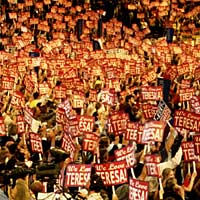
I will review Teresa Heinz Kerry, since she is the most controversial figure in the 2004 campaign. The controversy is undeserved: Teresa Heinz Kerry is no Hillary Rodham Clinton. I heard her speak several times and underneath her exotic image Teresa Heinz Kerry is a traditional political wife, which Hillary wasn't. When she told the gay meeting that if her husband was elected they would have a mom in the White House, she meant it. Supporting other people is what she likes to do.
The national nominating conventions of both parties ain't what they used to be and neither are the parties. Some changes have been for the better, but a lot of what made them magnets for political connoisseurs has been lost. Between 1964 and 1980 the Democratic Party underwent a revolution which saw a shift in its base, its priorities, and its procedures. That was fascinating to watch. Most of what's happened since then has been just a tidying up of loose ends while trying to elect a ticket. The Republican Party also underwent a transition, but not as thorough.
The quadrennial conventions no longer nominate; that is done by the primaries (and sometimes before the primaries). In 2004 the Democrats dispensed with nominating speeches, which in the past at least allowed the virtues of the also-rans to be put before the public.
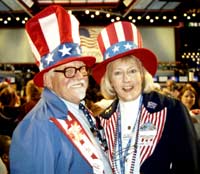
The DNCC put all the other candidates on the program, but they mostly spoke about John Kerry. The excitement of the roll call, even when you know who the winner will be, is gone, as is the "real" delegate count. The DNCC held a proforma roll call on Wednesday night after the program was over, but few delegates voted their preference or their commitment before shifting to the designated nominee.
Nor does anyone debate or even listen to the Platform. The Platform is written by the campaign committee of the nominee-to-be long before the convention. The official Platform Committee meets well before the convention and suggests small changes, but doesn't make any without the campaign's approval; 1992 was the last time there was a minority report and the debate it generated was bland.
Watching disagreement over the Platform and disputes in the other convention committees used to provide a window into intra-party differences, but no more. Everything is carefully scripted to minimize surprise and divert dissent away from the candidate. Political conventions are no longer political.
The rules of engagement for the Fleet Center were posted on a large sign outside the entrance to the metal detectors. Among the items prohibited from entry into the hall were "banners, signs or placards." The convention co-ordinators made all the signs they wanted to be seen by the ever present TV cameras. On cue, dozens of yellow-vested sign cops passed them out in quantity and signaled when they wanted them raised or lowered. Some speakers were honored by thousands of waving signs bearing their names; some only saw them flashing from the states they represented; some had to make do with applause.
The Democrats put on a good show. mixing speeches with entertainment, live and video segments. Even though I couldn't see the screens where the video portions were shown from the writing press stands, they sounded good. Jeff Kent, who is in charge of photographers at the Conventions, let me have a photographer's floor pass for an hour while Ted Kennedy was speaking so I could shoot some local color and get closer to the podium than the upper balcony.
The Democrats tried to co-opt the Republican themes of family values and national defense through the use of symbols and speeches. Having both wives and some of the Kerry and Edwards children speak to the multitudes was a convention first. Having those military flag officers stand up for Kerry and triple amputee Max Clelland introduce him may not have been a first, but was intended to highlight the fact that Kerry went to war (a war he later denounced) while Bush was dodging the draft.
The Special Interest Group Meetings
The Democratic Party is and always has been a pluralistic party where interest group identification is encouraged. Groups are harnessed to charge in the same direction -- toward victory in November -- though there have been years in which they pulled the party apart (e.g. 1968). However, the nature of the groups has changed over time. The revolution in the Democratic Party began in 1964 over the issue of representation when the racially integrated Mississippi Freedom Democratic Party (MFDP) challenged the right of the all-white Mississippi regulars to sit in that state's seats at the convention.
By the time the revolution was over in 1980, demographic representation had been added to geographic representation as a mandate. The national Charter written in 1974 that prohibited demographic discrimination was amended in 1980 to require equal division between men and women in all national committees and conventions, and all state central committees.
1980 was also the year that a significant "gender gap" appeared in a Presidential election for the first time since 1932. The year that the party mandated that women be 50 percent of all national party bodies, women become 60 percent of the Democrats electoral base.
The DNC sponsored numerous special interest group meetings on the second floor of the Sheraton, the headquarters hotel. These were open to anyone, not just people with credentials. The women's meeting has always been the largest, and previously met on all four convention days.
This forced women who were also black, hispanic, lesbian, etc. to chose between the women's meeting and the other special group caucuses; ethnic women generally chose their ethnic caucus while lesbians left the GLBT meeting to the men.
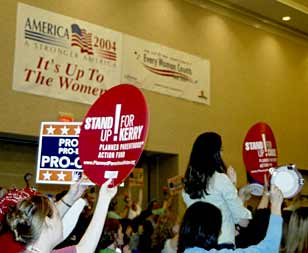
This time each caucus met only twice: women on Tuesday and Thursday morning (followed by meetings of seniors and youth) and the other caucuses on Monday and Wednesday. The number of women of color in the women's meeting jumped, as did the number of women in the GLBT caucus.
After the women, the African-American and GLBT caucuses were the largest, drawing 200-250 people to each meeting; 40 to 50 percent were women. There were also meetings for Latinos, Asian-Pacifics, American Indians, People of Faith, Rurals, Veterans, the Disabled and a generalized Ethnic caucus.
I estimated the percent of women at all of the meetings I visited. Female presence ranged from 10 percent at the Vets caucus to 75 percent at the AFSCME meeting, but generally hovered between 33 and 40 percent.
Various Union groups also held their own meetings. I spent a lot of time at the AFSCME meetings, which was warm, friendly and small enough for unimpeded camera shots. Next to the platform stood life-sized paper cut-outs of the Four Republicans of the Apocalypse -- Bush, Cheney, Rumsfield and Ashcroft -- which guests were invited to bop with beanie bags after they spoke.
At one time the group meetings were forums for debate; now they are just rallies for the faithful. The top pols, and the wannabees, make the rounds of as many as they can so it's a good chance to see them up close. I heard Teresa Heinz Kerry at the GLBT meeting, Howard Dean at the Latino meeting, Kamala Harris (DA of San Francisco) at the AA caucus, and Barney Frank and Tammy Baldwin at the AFSCME meeting.
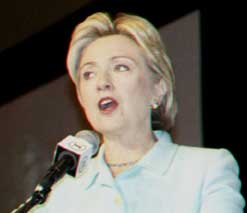
The Tuesday women's meeting featured Hillary Clinton, Madeleine Albright, Barbara Mikulski, the Sanchez sisters and Donna Brazile. Standing in the corner where the ramp met the platform, I got some great shots of great women that morning.
On Thursday, the powers-that-be decided to keep photographers at least 20 feet away from the podium. My lens isn't long enough or my flash powerful enough to shoot anything worth seeing from that distance. When I went around to get a quick shot of former Secretary of Labor Alexis Herman from right below the podium, a young man from the DNC press office stood in front of me and all but pushed me out of the way. "Security" he said.
When I tried to occupy a vacant seat in the front row, the woman sitting next to it told me that seat was taken, even though only by her bags. I did get a spare seat in the third row, which was barely close enough to shoot from, but when I held up my camera, the DNC staffer was there again, keeping me from shooting anything decent. When I explained that I couldn't shoot from so far away, he threatened to throw me out if I persisted in trying to get closer.
Nor could I get near to the VIP pen, on one side of the ramp, to take photographs of the women waiting their turn to speak. I asked the name of my pursuer. Brian, he said, Brian Richardson. I later learned that there is no one by that name on the DNCC staff.
Pissed as hell, I retreated to the back of the room, where I ran into my friend Gale Brewer, long time New York City activist and currently a member of the NYC City Council. We kept each other company for the rest of the women's meeting. I grumbled about missing a great shot of our mutual friend, Peggy Kerry, standing up for her brother with their sister Diane.
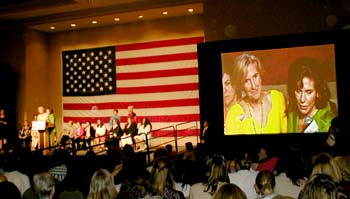
My Two Seconds of Fame
Teresa Heinz Kerry was the featured speaker of the Thursday women's meeting, and the supposed reason for the extra "security." She was late.
Susan Turnbull, Deputy Chair of the DNC and former chair of its women's caucus, took on the job of keeping the crowd occupied while we waited. She asked several questions of the audience which required calling out or standing up in reply.
"Everyone here for their first convention" she said. About half the crowd stood up. Next she had everyone else stand and the first timers sit-down. "Everyone here for their second convention sit-down," third...., fourth...., fifth..., sixth.....
"This one is mine," I told Gale. "I'm going to be the last one standing." We'd been sharing a seat on the edge of the audience, and both of us were standing next to it. When Turnbull got up to ten conventions, there were only a couple of us left standing and I was afraid she wouldn't see me on the outskirts mixed in with those who didn't have seats.
I got up on the chair and called out "TWELVE". The audience broke out in applause. As I got down from the chair, someone yelled out "from where?" "New York" Gale yelled back on my behalf.
After the meeting was over I was perusing the buttons and literature in the entry area when several people came up and asked me how I had gone to so many Democratic conventions. Two young women did the same as I was walking to the Fleet Center that evening.
In 1960 I lived in Los Angeles, I told them, and my mother took me to hear John F. Kennedy's acceptance speech at the USC Coloseum. In 1964 I hitchhiked to Atlantic City to participate in the MFDP vigil. I was living in Chicago in 1968, and had obtained press credentials in order to write about it, so that one was easy. In 1972 I was a Shirley Chisholm alternate with the Chicago Challenge delegation which unseated Mayor Daley. In 1976 I was a reporter again, and have been one ever since.
When I added that I almost didn't didn't come to this convention and why, two people offered me spare bedrooms for the night. But it was Thursday, and I intended to leave on the 11:30 p.m. bus. Too bad I didn't get my two seconds of fame on Tuesday.
Security
Everyone knew that security would be tighter than ever before. All trash cans were removed from the city's sidewalks so no one could put a bomb inside. The locals deserted the business district. The streets were not crowded and the stores were not packed. Afterwards the Mayor apologized to the business community for all the lost business.
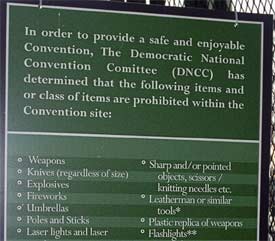
Prohibited from the Fleet Center were coolers, containers of any type (bottles, cans or spray), umbrellas, laser pointers, knitting needles, flashlights, noise-makers, unopened envelopes or packages, and more. Employees of several big news organizations had received terrorism defense training and been issued kits which they were told to keep close at hand. Many of the items in those kits (e.g. flashlights and whistles) were confiscated at the security perimeter. At least the wait in line to go through the metal detectors was shorter than the hour required in 1996, and no one asked me to open my camera to prove it wasn't a weapon in disguise, which happened in 2000.
Some of it was pseudo security. The Sheraton was next to still another convention center where political training was being conducted. Both were accessible through a shopping mall. However, guards at the Sheraton entrance prevented anyone but hotel guests with special cards from entering from the mall. The rest of us had to go outside and enter through the front of the hotel, where no one stopped or searched us. From there we could go to the second floor, where most of public events were held, and out the door that the guards wouldn't let us enter.
Often security was just an excuse for stupidity. While walking down the hall at the Fleet Center that led to the press filing room, I saw a cart of Teresa signs roll out. That's a good shot I thought and pulled out my camera. No photographs, a young-woman-in-charge told me. "Security." A few other press people gathered around. One took out his camera and went up close to take what we all saw as a simple atmospheric photo. A DNC staffer jumped on the cart to put his body between the camera and the signs.
The Protests
It has become a tradition to have a protest march on Sunday before each convention. In the past, the biggest marches have been at the Democratic Convention, even though the protestors are more likely to vote Democratic than Republican. I missed this year's march against the Irag occupation organized by ANSWER due to my late arrival. It wasn't much of a march, which was predictable. No one doubts that it was the Republican Party that was responsible for the invasion of Iraq; the New York demonstration will draw out the crowd.
After the 1968 Democratic convention left the Chicago police looking like bad guys, convention city police set-up protest areas for those who have something to say while the party people are in town. These are never acceptable to the protestors. The squabble always goes to court, where a judge decides what is sufficiently within sight and sound of the convention arena to satisfy the First Amendment.
In Boston, the designated protest area was a narrow stretch of land underneath the elevated train outside the Fleet Center. It looked nearby on a map, but was a labyrinthine walk away. Monday night I could hear the sounds of protest from inside the security perimeter, but couldn't see anything and couldn't get there.
Tuesday I walked to the Fleet Center guided by a series of yellow-shirted volunteers who marked out the shortest walking route. Once there, I found the protest area, with more signs hanging from the fences than protestors listening to the speakers.
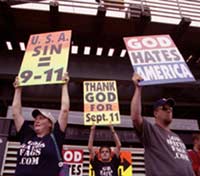
A strange group wearing T-shirts that proclaimed GOD HATES FAGS was holding forth from the speakers stand, verbally and visually. "Thank God for September 11" said one sign. While it was clear that they thought Democrats were faglovers, I couldn't figure out what that had to do with downing the World Trade Center.
Neither could the three cops who were hanging out next to the fence. I stopped to take their photo next to a sign that said "End the Occupation of Iraq", and one asked me to send him a copy. Nearby another sign declared this to be a "Protest Prison."
Those who wanted the people going inside the Fleet Center to see their signs did better by standing along the route to the metal detectors. There was plenty of room on either side of the fences for signs, stickers and banners (none of which could be carried inside).
In the Fleet Center Monday night I ran into Medea Benjamin and friends, dressed in their trademark pink. The Code Pink women have been doing spontaneous non-violent protests all over the place before and after the Iraq invasion. I asked if they were planning one here, and was told to be at the daily convention press briefing the next morning. I was, but the pink ladies were all no-shows.
Later I ran into them at the Sheraton, and was told to come again the next day. History repeated itself. I sat in the front row, camera ready, but my advance warning was a pink herring. Their only appearance was the unfurling of a banner on the floor that read "End the Occupation of Iraq" as Teresa Heinz Kerry spoke Tuesday night.
While I commend their ingenuity on getting it past the security searches and onto the floor, I'm not sure anyone saw that banner apart from the gendarmes who threw them out. I had a good view of the audience from the writing press stand, and whatever unauthorized banner was out there was obscured by thousands of red Teresa signs. They would have gotten more attention unfurling it at the morning press briefing.
On the way to the Fleet Center I saw a small gathering of Vietnam Vets Against Kerry, who had spurned the protest zone. Many of them were Vietnamese. They wore signs which said "Benedict Kerry Betrayed Vietnam Veterans." The speaker called Kerry a traitor to his country, among other things. This group is small, but it will plague Kerry for the rest of his campaign.
Kerry isn't hiding his anti-war work; it's in his official campaign bio. But he isn't promoting it either, even though his most fervent support comes from anti-war activists. (A CBS delegate poll found that 93 percent of the delegates felt that "the war with Iraq was not worth the loss of life.") Rather he's trying to finesse the whole thing by coming out strong for national defense. That's a narrow plank to walk.
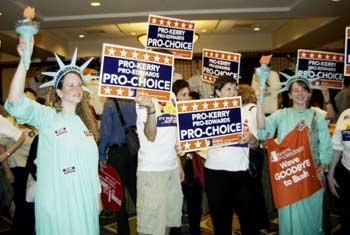
The most effective protests were more reminders than protests. The pro-choice women were everywhere. Sponsored by NARAL and Planned Parenthood, they passed out stickers and buttons at the Sheraton, on the streets and inside the Fleet Center. Abortion is a litmus test issue for both parties; no Democrat can run for President who isn't pro-choice and no Republican who isn't pro-life. Just in case you didn't know that, the pro-choice women were there to remind you.
Equally effective but completely outside the convention were the Falun Gong. On the Boston commons in full view of the street, practioners acted out the different tortures they receive for their beliefs in China. The sat in fake cages and bled fake blood. Printed signs described in detail the destruction of individuals by Chinese authorities. Did they have any trouble getting a permit, I asked. None whatsoever, I was told.
One result of the 1964 revolution is that yesterday's protestors are today's Democrats. Delores Huerta, co-organizer of the United Farm Workers, is heading Women for Kerry. The late Fannie Lou Hamer, the MFDP leader who became famous for telling the world that "I question America" while outside the 1964 Democratic Convention, was celebrated on Tuesday night inside the 2004 convocation with a poem by Maya Angelou and a video tribute.
Her political descendants play major rolls in the Democratic Party. In 1964 blacks were 2.8 percent of Democratic delegates; in 2004 they were 20.1 percent; 57 percent of these were women. Alice Huffman, president of the California NAACP, was in charge of the entire convention as Chair of the DNCC. Two of the three women to pursue the Democratic nomination for President were African-Americans. Black Democratic women have their own PAC; its reception at the Sheraton was packed.
The Parallel Conventions
Another new tradition are parallel conventions, paid for by private parties or organizations. These change from convention to convention so lack the continuity of the main event. They are held in the convention city during the same week to take advantage of the gathering of press, protestors, politicians and persons of prominence.
This year the left wing of the Democratic Party spent three days talking about how to Take Back America at a hotel in Cambridge.
There isn't much of a line between the left wing of the party and its center. Here were found many of the sentiments and signs delegates would have liked to wave at the Fleet Center, had they been permitted to bring their own. Many of the best known speakers served in the Clinton Administration (Robert Reich) or also addressed the Democratic Convention (Jesse Jackson, Howard Dean, Dennis Kucinich). They were supplemented by numerous elected officials and union presidents (including John Sweeney), plus a few veteran activists. If Kerry wins, most of them will be White House insiders, not convention outsiders.
Meeting a little further away and a bit further to the left, former Nader and Kucinich supporters formed the Progressive Democrats of America. Viewing Nader's candidacy as a "wake-up call," they argue that supporting Kerry is the way to transform the Democratic Party, but believe that beating Bush is THE issue this time. If Kerry wins, they'll still be outsiders.
At still another convention center on the other side of Boston, 3,147 Revolutionary Women also held their inaugural event in Boston on Tuesday. Describing itself as a "nonprofit membership organization" to advance the progressive, political leadership of women , RW was founded and is run by Bostonian Barbara Lee, a philanthropist and "social justice activist" committed to women's empowerment.
The long list of female luminaries who addressed the workshops or the afternoon rally surpassed those at the official DNCC women's meetings. I sampled each of the workshops; those with the biggest names had the largest attendance. The workshops on how to do practical politics were the smallest. In the exhibit area the booth set up to support Hillary Clinton had the largest crowd. Women won't be revolutionary until they see practical political skills as more important than stars.
In the same center at the same time, the venerable Emily's List held its usual convention $250 per ticket fundraiser. I arrived just as the women were pouring into the streets after it was over so I can't tell you how great it was. But I did make Emily's breakfast on Tuesday morning for women "political newsmakers and journalists," where the lesser female luminaries came to schmooze. I sat down with Ellie Smeal to talk about whether feminists were integrated into the Democratic Party or not (she said no, I thought yes), chatted with Ann Lewis and Susan Turnbull, and picked up a "Ms. guide to Women's events at the Democratic National Convention." That was a great place to find out what women were doing; would that Emily had hosted such a breakfast every morning.
Over all, there was something for almost everyone at this year's Democratic Convention. You didn't even have to be a Democrat.
Photos by Jo Freeman
Please click on thumbnails to view the complete image
At the Women's Caucus
To Top
Books by Jo | What's New | About Jo | Photos | Political Buttons
Home | Search | Links | Contact Jo | Articles by Jo
